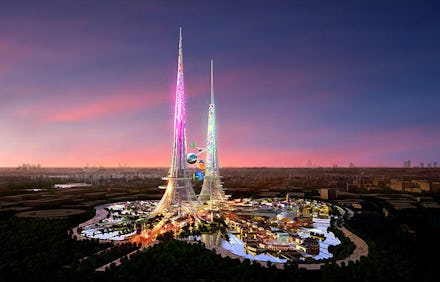These Futuristic Skyscrapers Could Break Height Records And Solve a Major Problem at the Same Time

These two gigantic skyscrapers could be the tallest buildings in the world — and they would scrub the air of pollution.
Image credit: Chetwoods
Construction of the mega futuristic towers in Wuhan, China, could be completed by 2017 or 2018 pending the approval of the city's mayor.
The taller of the two buildings will have a planned height of almost exactly a kilometer, beating out Dubai's Burj Khalifa as the tallest man-made structure in the world. According to Fast Company, they'll also be extremely environmentally friendly and may even help restore local air quality. Built on an island within a lake, the larger of the two buildings sucks up air and water cleans it, and then puts it back. Both towers will have pollution-absorbent coatings designed to help tone down local air pollution, and vertical gardens to help clean more air. The bigger building has a central chimney designed to help ventilate the structure naturally.
Local lake "water goes up through a series of filters," Laurie Chetwood, chairman of Chetwoods. "We don't use power to pull the water up, we're using passive energy. As it goes through the filters and back, we're also putting air back into the lake to make it healthier."
Image credit: Chetwoods
As an added bonus, the towers could feature photovoltaic cladding and wind turbines, making them generate sustainable electricity.
The two towers will be known as the Feng (male) and Huang (female) towers, coming from the Fenghuang, a mythical Chinese bird. "We were asked to create an iconic building for Wuhan, which embodied a strong environmental and social content as well as reflecting Chinese tradition," Chetwood says.
If approved in time and built quickly, the project could outpace Saudi Arabia's Kingdom Tower in Jeddah, which will reach the same height but not until 2019.
Other strange new eco-friendly projects that could happen in the near future include a 2,250 foot (686 meter) solar-wind energy tower that could be built in San Luis, Arizona, by 2018.